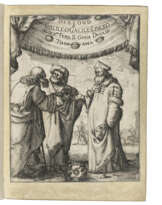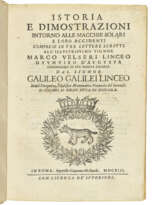ID 1032707
Lot 55 | Newe geometrische und perspectivische Inventiones etlicher sonderbahrer Instrument
Estimate value
$ 7 000 – 10 000
First edition of Ulm mathematician and military architect Johann Faulhaber's treatise on instrument making, containing the first published illustrations of Galileo's compass. This work is important not only for its engraved technical illustrations of Galileo Galilei’s famous compass—the first such illustrations to appear in print—but also for its revealing anecdote about how Faulhaber came to learn of the instrument and of its inventor in the first place. More accurately described as "Galileo’s Sector" to distinguish it from the various compasses which appeared in the late sixteenth century, it might be considered a forerunner of the pocket computer. The device, which Galileo invented around 1596, bears nine sets of lines or scales for calculating square and cube roots, determining interest rates, making monetary exchanges, squaring the circle, performing trigonometric calculations for surveying, and determining specific weights of metals and stones (essential for artillery). He first described it in a 1606 privately-printed manual meant to accompany the instrument, but with no illustrations to minimize the risk of piracy.
The present work explicitly credits Galileo with being the instrument’s first inventor and illustrates the two sides of the proportional compass on separate folding plates. Faulhaber relates "that his acquaintance with [the instrument] dated from a visit paid to him (probably in 1603) by Mathias Bernegger en route from Austria to Strassburg. Faulhaber had recognized the value of the instrument, although he considered some of its scales less useful than others that he put in their places. He said further that before publishing he had made careful inquiries to determine the name of the original inventor and had learned that this was Galileo Galilei, professor of mathematics at Padua. Because Bernegger seems never to have visited Italy, it is probable that he had seen the silver example of the instrument sent by Galileo to the Archduke of Austria and in that way knew of its inventor" (Drake).
In two further sections of the present work, Faulhaber offers a survey of perspective devices published by others, including Dürer and Jamnitzer, and discusses his improvements to several (non-Galilean) instruments used in the accurate construction of pictorial perspective and presents a "secret invention" for land surveying (the secret is magnets!). Tomash F-22; Poggendorf, I, 725. See also, Stillman Drake, Galileo Galilei: Operations of the Geometric and Military Compass, 1606 (1978).
Quarto (193 x 143mm). Title in engraved border, engraved arms on dedication page, 3 engravings in text and 3 folding engravings (waterstain affecting about 12 pages, repaired tear in one plate). Modern quarter tan calf and pasteboard with title gilt on spine, red sprinkled edges.
| Artist: | Galileo Galilei (1564 - 1642) Johannes Faulhaber (1580 - 1635) |
|---|---|
| Place of origin: | Germany |
| Auction house category: | Medicine & science, Printed books |
| Artist: | Galileo Galilei (1564 - 1642) Johannes Faulhaber (1580 - 1635) |
|---|---|
| Place of origin: | Germany |
| Auction house category: | Medicine & science, Printed books |
| Address of auction |
CHRISTIE'S 20 Rockefeller Plaza 10020 New York USA | ||||||||||||||
|---|---|---|---|---|---|---|---|---|---|---|---|---|---|---|---|
| Preview |
| ||||||||||||||
| Phone | +1 212 636 2000 | ||||||||||||||
| Fax | +1 212 636 4930 | ||||||||||||||
| Conditions of purchase | Conditions of purchase | ||||||||||||||
| Shipping |
Postal service Courier service pickup by yourself | ||||||||||||||
| Payment methods |
Wire Transfer | ||||||||||||||
| Business hours | Business hours
|









![[GALILEO GALILEI (1564-1642) and Girolamo SPINELLI (c.1580-1647)]](/assets/image/picture_4734998/81ecb/b78ba02793ea9f7c89bc2421c803edfc1752012000jpg__fix_162_205.jpeg)




